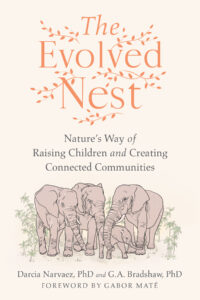How to Connect in a Civilization of Disconnection
Connecting to self, others and Nature
According to Jon Young, deeply wise about our ancestral practices, the job of a culture is to support meaningful connection. This is what traditional cultures do. They connect community members to ancestors, to future generations, and to the natural world. Individuals are connected to their deeper evolved nature and to one another.
What does it mean to be connected? Connection is about sharing our deeper selves, our beingness, with one another. We are fully present emotionally and mentally. We tune into our species evolved capacities for attunement to the world.
 According to Jon, western civilization is a disconnection machine, disconnecting us from ourselves, from one another, and from Nature. The dominant civilization shuts down the individual self, thwarting its development and its connectedness. The dominant civilization focuses on the conscious mind and alienates it from the deeper self. Disconnectedness from self is accompanied by disconnection from others. After all, we find ourselves in our relationships with others.
According to Jon, western civilization is a disconnection machine, disconnecting us from ourselves, from one another, and from Nature. The dominant civilization shuts down the individual self, thwarting its development and its connectedness. The dominant civilization focuses on the conscious mind and alienates it from the deeper self. Disconnectedness from self is accompanied by disconnection from others. After all, we find ourselves in our relationships with others.
Jon Young learned humanity’s deep ways of connecting that have been practices for hundreds of thousands of years among our cousins, the San of the Kalahari, whose ancestors are all of our ancestors. They still practice ways of living and being that match up with our deeper human propensities. You could say that they still know and apply the software that goes with the hardware of our species.
In hundreds of intervention projects Young has conducted around the world, he and his colleagues have applied the practices of connection learned from the San. The San take a great deal of time with these practices, with one another, with arriving strangers, ensuring the bonding the practices promote. What are those practices?
First, create the space to slow down and experience the now.
Second, acknowledge, look at, and truly see one another. Be present to each other. This takes some practice if you were raised in a culture of disconnection.
Third, sincerely welcome one another. This again can take practice if you are used to holding people at a distance and shielding your feelings.
Fourth, make sure each person actually feels welcome. You might need to check. Everyone needs to be listened to.
Fifth, shake the dust off. Acknowledge where you just came from, letting go of whatever preoccupations you arrived with.
Sixth, express gratitude for something you feel at the moment. This puts you into a mindset outside of ego and self.
Applied for several weeks, these practices will transform relationships and transform the individual.
These ways of being together are contrary to the efficiency orientation that we’ve been taught. But it turns out that when you apply these practices in work life, the team is more creative and productive. In family and community life, people will feel like they matter, like they belong, and its much easier to cooperate and problem solve. Deep human nature will be activated. Everyone will be more flexible and attuned, more generous and kind.
Jon Young’s work around the world shows that connection practices heal social and mental illbeing. The San grow 100% of their potential, their genius, by being connected all the time.
These practices also work when you are in the natural world, paying attention to the entities you are with. Slow down into a sense of timelessness. Let go of any preoccupations you bring so you can be fully present. Notice where you are. Practice cat walking—take ten steps and then stop and look around. Welcome the entities (animals, plants, rocks, water, clouds) as relational partners. Feel their welcoming of you. Feel gratitude for Nature’s beauty and presence.
Remember that to know something you can’t just think it, or want it, you must practice it. With each practice we grow back into our original humanity. It’s a process of becoming.
Each day we can practice connecting wherever we are. Returning to and maintaining connection practices are fundamental for saving our species from its ongoing mindlessness. It is essential for supporting the wellbeing of Earth.
Bibliography
Henn BM, Gignoux CR, Jobin M, Granka JM, Macpherson JM, Kidd JM, Rodriguez-Botigua L, Ramachandran S, Hon L, Brisbin A, Lin AA, Underhill PA, Comas D, Kidd KK, Norman PJ, … … Feldman MW, et al. (2011). Hunter-gatherer genomic diversity suggests a southern African origin for modern humans. Proceedings of the National Academy of Sciences of the United States of America. 108: 5154-62. DOI: 10.1073/Pnas.1017511108
Young, J. (2019). Connection modeling: Metrics for deep nature-connection, mentoring, and culture repair. In D. Narvaez, Four Arrows, E. Halton, B. Collier, G. Enderle (Eds.), Indigenous sustainable wisdom: First Nation knowhow for global flourishing (pp. 219-243). New York: Peter Lang.
Jon Young’s talk: Earth Talk: Nature & Genius
Young, J., Haas, E., & McGown, E. (2010). Coyote’s guide to connecting with nature, 2nd ed.. Santa Cruz, CA: Owlink Media.

